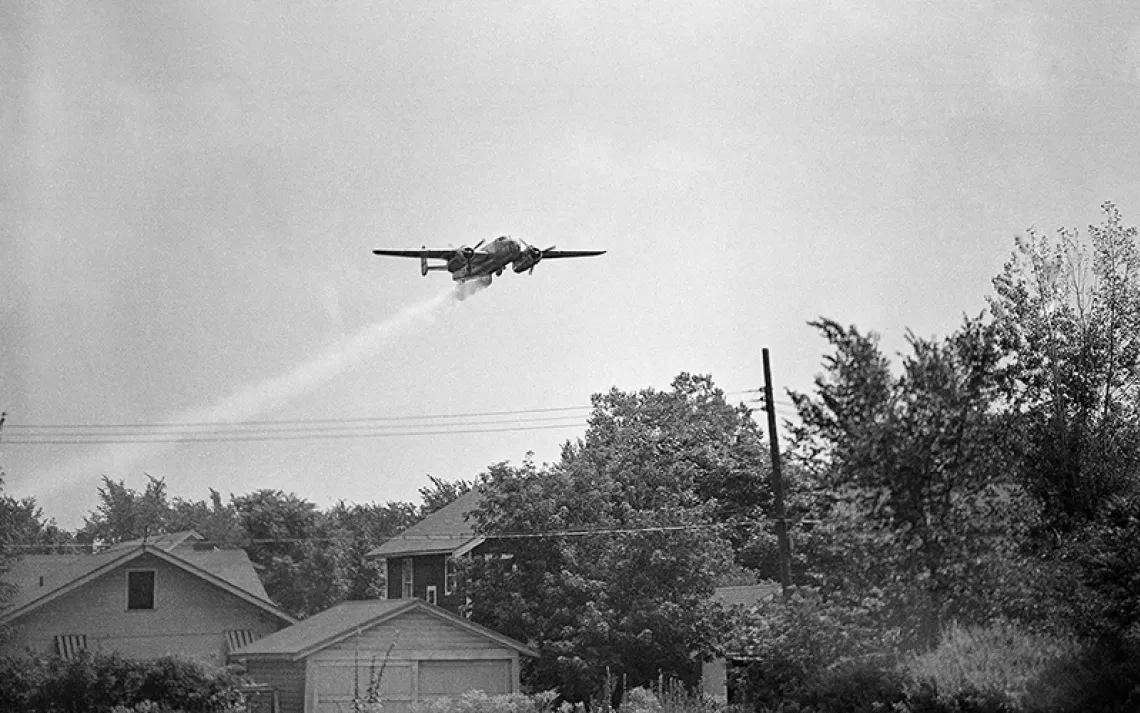Colombia to Resume Fumigating Its Coca Fields With Glyphosate
It's happening under the cover of strict coronavirus lockdown measures
Colombia is about to dust off a controversial weapon from the bloodiest period of the South American nation's decades-long battle against cocaine production: aerial fumigation of coca fields. The raw ingredient used to make cocaine, coca is illegal to cultivate and has long had a destabilizing effect on Colombia. But reactivating the eradication program, environmentalists say, will wreak devastating health and ecological havoc on the vulnerable communities it targets, and on delicate ecosystems across the country.
Colombia is the only coca-producing country in the world that has utilized aerial spraying of glyphosate-based defoliants, which destroy plant life indiscriminately, as part of an anti-drug program. The country’s aerial fumigation program, which began in the 1990s and continued for 21 years, had a devastating ecological impact and indirectly exacerbated deforestation. The government halted the program in 2014 after a World Health Organization report found that the spray's main ingredient, glyphosate (also the main ingredient in Monsanto’s infamous commercial herbicide, Roundup), most likely causes cancer in humans.
But even before the release of the WHO report, use of the chemical in Colombia had a controversial history, with critics claiming the aerial fumigation program was counterproductive, ecologically and economically devastating (small farmers often grow coca alongside food crops, and aerial spraying destroys foliage indiscriminately), and a waste of money. Multiple experts in Colombia told Sierra they are particularly worried about the effect of glyphosate on children, whose developing bodies are especially sensitive to caustic chemicals.
So why relaunch the program? In 2019, cocaine production in Colombia reached an all-time high. This past January, partly due to US threats to revoke more than half a billion dollars in foreign aid in the event Colombia failed to address rising cocaine production, President Iván Duque announced plans to resume the controversial program. The decision came on the heels of complaints from President Donald Trump, who last year claimed Colombia had “done nothing for us,” and went on to threaten to revoke the country’s status as a partner in the War on Drugs—a move that would put America’s closest ally in Latin America in the same category as Venezuela, where the US has levied charges of organized narco-trafficking against the federal government.
Much like how the US government has been quietly loosening environmental restrictions in recent months, Colombia's federal government ramped up manual coca eradication efforts under the cover of strict nationwide lockdown measures due to the global coronavirus crisis. Because Colombia's municipal governments, human rights organizations, and environmentalists have challenged the program at the municipal level, implementation has been delayed. Still, the federal government has announced a goal of achieving final approval for aerial spraying by the end of June.
Botanist and ecologist Alberto Gómez worked with the Colombian government on its coca eradication program from 2002 to 2009. After witnessing a fumigation operation in Putamayo, a hot spot for coca production on Colombia’s Ecuadorian border, Gómez described being stunned by the ecological devastation he witnessed. “I remember standing near the border, looking at thousands of hectares of Colombian forest burnt to ashes,” he told Sierra. “And just a few meters away, I saw the pristine, untouched forests of Ecuador. That’s when I knew we had to find an alternative solution.”
Gómez explains that 40 species of flora exist only in the forested Putamayo region of Colombia. “We were destroying our greatest national gift, our biodiversity, for a program that wasn’t working.”
David Restrepo, environmental director for the Center of Security and Drug Studies at the University of the Andes, says the EPA’s (highly controversial) health findings on glyphosate fail to account for long-term exposure to children. “What’s more, the studies saying glyphosate is relatively safe were done on factory farms in stable conditions in the US, not on families growing yuca in a conflict zone. There is no parallel.”
Adds Alvaro Jimenez Millan of CCCM, director of an organization that clears anti-personnel mines left by state forces and armed groups in conflict zones, “We’re talking about bombing families and children in conflict zones in Colombia with caustic chemical agents, a program that led to grave human rights violations the last time it was implemented.”
But the real damage, says Restrepo, is caused by the secondary effects of fumigation. During the height of the program in the early 2000s, growers often fled into protected areas of the rainforest and national parks to avoid being pursued, or planted smaller coca fields among food crops, cutting down forestlands as they were displaced.
A 2019 report from WOLA, a human rights advocacy group in Latin America, outlines in detail the damage that glyphosate inflicts on the water table in the regions it is used as well as what WOLA describes as "triple deforestation." Here's how it works: Forests are cleared to adapt the land for the illicit crops. Then, aerial fumigation directly causes indiscriminate deforestation and damage to food crops before, finally, growers flee to new regions to plant again, launching new cycles of deforestation all over again.
Official figures from the Institute of Hydrology, Meteorology, and Environmental Studies in Colombia indicate that deforestation reached 124,035 hectares (over 300,000 acres) in 2015 as a direct result of this program. And a great deal of coca is grown in the Amazon region of the country, where delicate rainforest ecosystems are particularly vulnerable to the damage caused to the water table and to indiscriminate defoliation.
“Aerial fumigation is not effective,” reiterates Gómez. “During my time in the program, coca fields eradicated by the government had a 70 percent replantation rate. But worse, growers developed countermeasures to the spraying, such as coating the leaves with nonbinding substances when they heard the planes coming, harvesting immediately after a spray, and replanting or simply moving to jungle areas where they are harder to detect.”
Gómez proposed a program to the Colombian government in 2015 that would use one of coca’s natural predators, a moth known by locals in the Amazon as “the gringo” due to its insatiable appetite for coca, as a natural and sustainable method to battle production in Colombia. (The study involving the moth, Eloria noyesi, was ultimately abandoned, due to the moth's inability to survive in the cold climate of the Andes mountains, which cover nearly half the country.)
In a country that only recently signed a peace accord in 2017 after a 50-year civil war, the decision to fumigate coca fields won’t only risk disastrous environmental effects—it may also threaten an increasingly shaky peace accord, as armed groups in the large regions of the country known for coca cultivation are using the situation to their advantage.
Recruitment among rebels has nearly doubled as residents in conflict zones increasingly perceive the Colombian government as either unable or unwilling to provide peace or fulfill its promises from the 2017 agreement.
“The peace is in a critical position, and this is likely to make it worse,” says Sergio Guzman, director of Colombia Risk Analysis. “When farmers are being bombed as part of this program, [armed groups] are likely to say to these communities, ‘Do you know who isn’t burning down your crops? The guerillas.'”
 The Magazine of The Sierra Club
The Magazine of The Sierra Club




